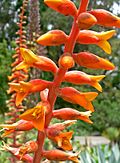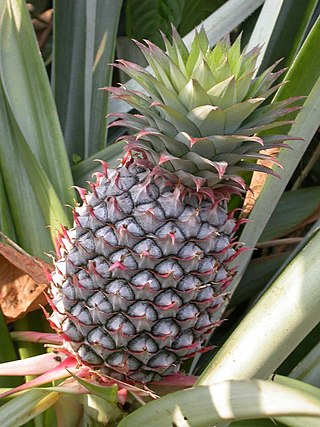
The Bromeliaceae are a family of monocot flowering plants of about 80 genera and 3700 known species, native mainly to the tropical Americas, with several species found in the American subtropics and one in tropical west Africa, Pitcairnia feliciana.

Brodiaeoideae are a monocot subfamily of flowering plants in the family Asparagaceae, order Asparagales. They have been treated as a separate family, Themidaceae. They are native to Central America and western North America, from British Columbia to Guatemala. The name of the subfamily is based on the type genus Brodiaea.

Puya is a genus of the botanical family Bromeliaceae. It is the sole genus of the subfamily Puyoideae, and is composed of 226 species. These terrestrial plants are native to the Andes Mountains of South America and southern Central America. Many of the species are monocarpic, with the parent plant dying after one flower and seed production event.
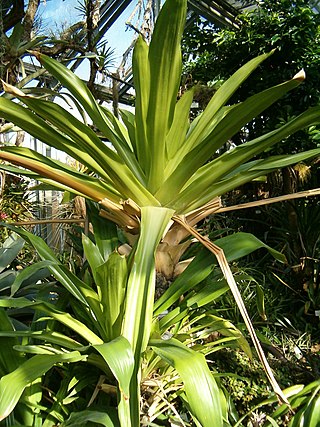
Brocchinia is a genus of the botanical family Bromeliaceae, and is the sole genus of the subfamily Brocchinioideae, containing 20 species. The genus is named for Giovanni Battista Brocchi, Italian naturalist (1772–1826). Brocchinia species are native primarily to the ancient Guayana Shield in southern Venezuela and Guyana, with some species extending into Colombia and northern Brazil. Its species are generally restricted to areas of sand and sandstone of the Roraima Formation; a few occur on granite.
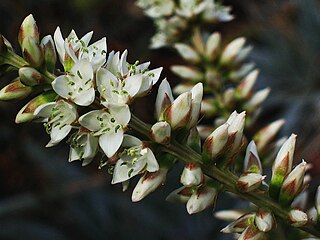
Hechtia is a genus of plants in the family Bromeliaceae, and is the sole genus of the subfamily Hechtioideae, containing 75 species. Its species are native to Mexico, Central America, and Texas.
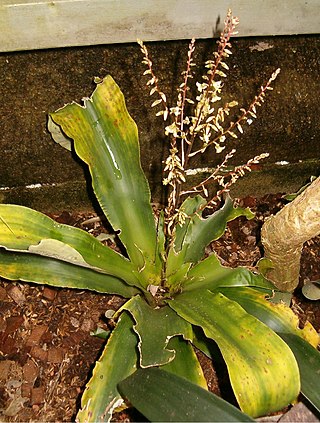
Fosterella is a genus of plants in the family Bromeliaceae, subfamily Pitcairnioideae. It contains 31 recognized species, 30 native to central and western South America, one to Mesoamerica. The genus is named after Mulford B. Foster, American horticulturist and collector (1888-1978).
Brocchinia uaipanensis is a species of bromeliad endemic to southern Venezuela. It has been treated as the sole species in the genus Ayensua under the synonym Ayensua uaipanensis, but Ayensua is now included in Brocchinia. The species was first described in 1957 by Bassett Maguire as Barbacenia uaipanensis.

Cryptanthus is a genus of flowering plants in the family Bromeliaceae, subfamily Bromelioideae. The genus name is from the Greek cryptos (hidden) and anthos (flower). The genus formerly had two recognized subgenera: the type subgenus and subgenus HoplocryptanthusMez which has been raised to the separate genus Hoplocryptanthus. All species of this genus are endemic to Brazil. The common name for any Cryptanthus is "Earth star".
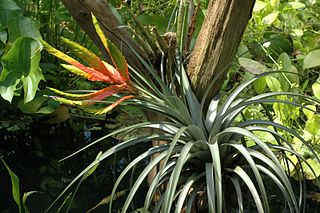
Tillandsioideae is a subfamily of plants in the bromeliad family Bromeliaceae. This subfamily contains the greatest number of species. Most are epiphytic or lithophytic, growing in trees or on rocks where they absorb water and nutrients from the air. Spanish moss of the genus Tillandsia is a well-known species. Bromeliads in the genera Guzmania and Vriesea are the more commonly cultivated members of this subfamily.

Pitcairnia is a genus of plants in the family Bromeliaceae, subfamily Pitcairnioideae. It was named for William Pitcairn, Scottish physician and gardener (1711–1791). The genus Pitcairnia ranks as the second most prolific of the bromeliad family. They are most abundant in Colombia, Peru and Brazil, but can also be found in areas from Cuba and Mexico south to Argentina. One species, Pitcairnia feliciana, is found in tropical West Africa and is the only member of the family Bromeliaceae not native to the Americas.
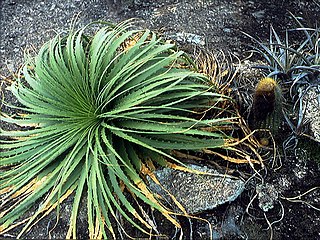
Encholirium is a genus of plants in the family Bromeliaceae, subfamily Pitcairnioideae. The entire genus is endemic to Brazil. The genus name is from the Greek “enchos” (spear) and “leiron” (lily).

Navia is a genus of plants in the family Bromeliaceae, containing 95 species. Described as early as 1830 in Guyana, they are commonly cultivated for their colorful foliage and inflorescences. All the species are native to northern South America.

Glomeropitcarnia is a genus of the botanical family Bromeliaceae, subfamily Tillandsioideae. The genus name is from the Latin “glomero” and the genus Pitcairnia. It has two known species, native to Venezuela, Trinidad and the Lesser Antilles.
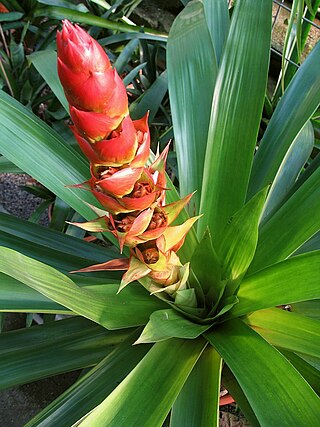
Mezobromelia is a genus of the botanical family Bromeliaceae, subfamily Tillandsioideae. The genus name is for Carl Christian Mez, German botanist (1866-1944). Some authorities treat Mezobromelia as a synonym of Cipuropsis.

Pitcairnia subg. Pepinia is a subgenus of plants in the family Bromeliaceae. It has at times been treated as the separate genus Pepinia, but is now included again in the genus Pitcairnia. The name is for Pierre Denis Pépin, French member of the Imperial and Central Society of Agriculture (c.1802-1876).
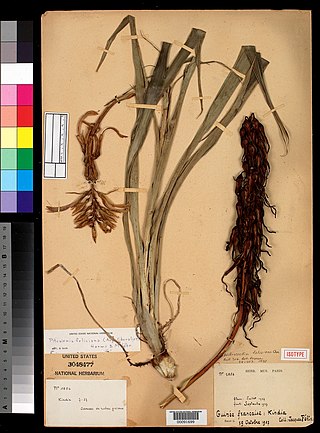
Pitcairnia feliciana is a plant endemic to central Guinea in West Africa and is the only species of bromeliad not native to the Americas. It can be found growing on sandstone outcrops (inselbergs) of the Fouta Djallon highlands in Middle Guinea.
Sequencia is a monotypic genus of plants in the family Bromeliaceae. The sole species is Sequencia serrata, endemic to the Vaupés region of Colombia.

Geogenanthus poeppigii, commonly called the seersucker plant, is a flowering plant species in the family Commelinaceae. As currently circumscribed, the genus Geogenanthus includes two other species, G. ciliatus and G. rhizanthus. This species is named after 19th century German naturalist Eduard Friedrich Poeppig. Geogenanthus undatus is an outdated synonym for G. poeppigii.

Navioideae is a subfamily of the bromeliad family, Bromeliaceae. It contains four or five genera, formerly placed in a more broadly defined subfamily Pitcairnioideae.
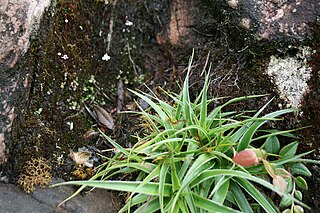
Lindmanioideae is a subfamily of the bromeliad family, Bromeliaceae. It contains two genera, which were formerly placed in a more broadly defined subfamily Pitcairnioideae.


